- NASA Home
- | Centers
- | Dryden Home
- | News
- | Fact Sheets
Search Dryden
Fact Sheets
Research Airplane Program
The Research Airplane Program was a joint research effort by the National Aeronautics and Space Administration (NASA--formerly the National Advisory Committee for Aeronautics or NACA) and the military services. It was conceived near the end of World War II to perform flight studies with a series of specially-constructed research aircraft in the then-unexplored transonic to low-supersonic characteristics of full-scale aircraft in flight.
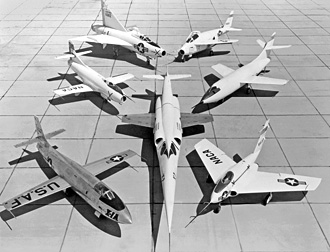
Although supersonic flight was first achieved in 1947, further research in the program resulted in notable increases in knowledge about the dynamics of piloted flight in winged aircraft at speeds up to and in excess of 4,500 miles per hour and at altitudes up to and greater than 350,000 feet.
Two general categories of aircraft were obtained for the research airplane program: (1) those needed to explore new areas of performance, such as the X-1, D-558-1, D-558-2, X-1A, X-1B, X-1E, X-2, and X-15; and (2) those required to investigate the effects of different airplane configurations, such as the X-3, X-4, X-5, XF-92, and the XB-70.
The outstanding contributions of this research program include providing important information on previously unexplored aircraft characteristics; validating the transonic-supersonic characteristics predicted by wind-tunnel tests and analytical techniques; and the intangible benefit of providing confidence in the achievement of safe, controllable, transonic-supersonic flight.
X-1, 1946-1951
The first of the rocket-powered research aircraft, the X-1 (originally designated the XS-1), was a bullet-shaped airplane that was built by the Bell Aircraft Company for the U.S. Air Force and the NACA. The mission of the X-1 was to investigate the transonic speed range (speeds from just below to just above the speed of sound) and, if possible, to break the "sound barrier."
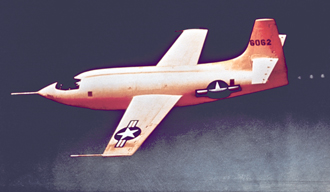
The first of the three X-1s was glide-tested at Pinecastle Army Airfield, Fla., in early 1946. The first powered flight of the X-1 was made on Dec. 9, 1946, at Edwards Air Force Base, Calif., with Chalmers Goodlin, a Bell test pilot, at the controls.
On Oct. 14, 1947, with Air Force Captain Charles "Chuck" Yeager as pilot, the aircraft flew faster than the speed of sound for the first time. Yeager ignited the four-chambered XLR-11 rocket engine after the B-29 air-launched it from under the bomb bay at 21,000 feet. The 6,000-pound thrust ethyl alcohol/liquid oxygen burning rockets, built by Reaction Motors Inc., pushed the aircraft up to a speed of 700 mph in level flight.
Yeager was also the pilot when the X-1 reached its maximum speed, 957 mph. Another Air Force pilot, Lt. Col. Frank Everest Jr., was credited with taking the X-1 to its maximum altitude of 71,902 feet. Eighteen pilots in all flew the X-1s. The number three plane was destroyed in a fire before making any powered flights.
A single-place monoplane, the X-1 was 30 feet, 11 inches long; 10 feet, 10 inches high; and had a wingspan of 29 feet. It weighed 6,784 pounds and carried 6,250 pounds of fuel. It had a flush cockpit with a side entrance and no ejection seat.
D-558-1, 1947-1953
A single-place, straight-wing, jet-powered aircraft, the D-558-1 "Skystreak" was manufactured by Douglas Aircraft Company for a joint Navy/NACA flight research program. It was designed to investigate jet-aircraft characteristics at transonic speeds, including stability and control and buffet investigations.

The D-558-1 was roughly 35 feet long and 12 feet high, with a wingspan of 25 feet. It weighed 10,105 pounds when fully fueled. One Allison J35-A-11 turbojet engine powered the D-558-1, which took off and landed under its own power.
The first flight of the aircraft, of which three were built, was on April 14, 1947, with Gene May, Douglas test pilot, at the controls. Its maximum speed of 650.8 mph, then a world record for turbojet powered aircraft, was achieved by then-Maj. Marion Carl, U.S. Marine Corps, on Aug. 25, 1947.
D-558-2, 1948-1956
Three D-558-2 "Skyrockets" were built by Douglas for NACA and the Navy. The mission of the D-558-2 program was to investigate the flight characteristics of a swept-wing aircraft at high supersonic speeds. Particular attention was given to the problem of "pitch-up," a phenomenon often encountered with swept-wing configured aircraft.

The D-558-2 was a single-place, 35-degree swept-wing aircraft measuring 42 feet in length. It was 12 feet, 8 inches in height and had a wingspan of 25 feet. Fully fueled it weighed from about 10,572 pounds to 15,787 pounds depending on configuration.
The first of the three D-558-2s had a Westinghouse J34-40 jet engine and took off under its own power. The second was equipped with a turbojet engine replaced in 1950 with a Reaction Motors Inc. LR8-RM-6 rocket engine. This aircraft was modified so it could be air-launched from a P2B-1S (Navy designation for the B-29) carrier aircraft. The third Skyrocket had the jet engine and the rocket engine but was also modified so it could be air-launched. The jet engine was for takeoff and climbing to altitude and the four-chambered rocket engine was for reaching supersonic speeds. The rocket engine was rated at 6,000 pounds of thrust.
The D-558-2 was first flown on Feb. 4, 1948, by John Martin, a Douglas test pilot. An NACA pilot, Scott Crossfield, became the first person to fly faster than twice the speed of sound when he piloted the D-558-2 to its maximum speed of Mach 2.005 (1,291 mph) at 62,00 feet altitude on Nov. 20, 1953. Its peak altitude, 83,235 feet, a record in its day, was reached with Lt. Col. Marion Carl at the controls.
X-4, 1950-1953
The X-4, a single-place, swept-wing, semi-tailless aircraft was designed and built by the Northrop Aircraft Company for NACA. It had no horizontal tail surfaces and its mission was to obtain in-flight data on the stability and control of semi-tailless aircraft at high subsonic speeds. The two X-4 aircraft were 23 feet long, 14 feet high, and had wingspans of 26 feet. They weighed almost 8,000 pounds at takeoff.
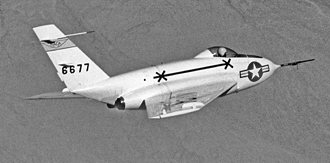
The X-4 was initially powered by two Westinghouse XJ30 turbojet engines and then by J30 turbojet engines with 1,600 pounds of thrust each. These engines boosted the X-4 up to speeds of 630 mph and up to altitudes of 43,300 feet.
The aircraft's maiden flight was on Dec. 16, 1948, with Charles Tucker, a Northrop test pilot, at the controls.
The X-4 helped demonstrate that tail surfaces are important for proper control effectiveness in the transonic speed range, and was also used to investigate the characteristic problems of tailless airplanes at low speeds, such as marginal longitudinal stability and control.
X-5, 1950-1954
The X-5 was the first aircraft capable of changing the sweep of its wings in flight. It was a single-place jet-powered aircraft, measuring 33 feet, 4 inches in length with a wingspan of 20 feet, 9 inches (with the wings swept back 60 degrees). The wings could be swept back 20 to 60 degrees. The X-5 weighed 9,875 pounds when fully fueled.
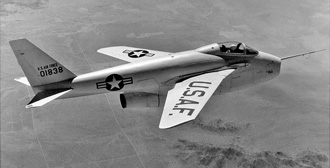
Its mission was to study the effect of wing-sweep angles of 20 to 60 degrees at subsonic and transonic speeds. Results from these tests provided some of the design background for the F-111 and the Navy F-14 tactical aircraft.
Two X-5s were manufactured by Bell Aircraft. The X-5 was powered by an Allison J35-A jet engine with a static thrust of 4,900 pounds. The maximum speed was 705 mph. The aircraft was equipped with an ejection seat.
The first flight was completed on June 20, 1951, with Jean Ziegler, a Bell test pilot, at the controls.
Results of the research program verified NASA wind-tunnel predictions for the reduced drag and improved performance resulting from increasing the wing sweep as the aircraft approached the speed of sound. Even the unfortunate spinning characteristics of the X-5 yielded a wealth of data for determining poor aircraft spin design.
XF-92A, 1951-1953
The XF-92A was this country's first delta-wing aircraft. It was flown to obtain data on the flight characteristics of a delta-wing aircraft in the transonic speed range.
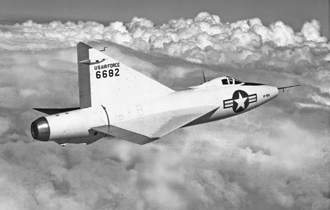
It was a single-place aircraft, 42 feet, 5 inches long and 17 feet, 8 inches high, with a wingspan of 31 feet, 3 inches. The XF-92A took off and landed under its own power using an Allison J33-A jet engine, equipped with afterburner capability.
The XF-92A was built by the Consolidated Vultee Aircraft Company (Convair). Stability and control, pitch-up, and lift/drag measurements obtained from the XF-92A helped build up the technology that was used to develop such delta-wing aircraft as the F-102, F-106, B-58 and other high-performance aircraft.
X-3, 1953-1955
A single-place jet aircraft, the X-3 had a slender fuselage and a long tapered nose. Its primary mission was to investigate the design features of an aircraft suitable for sustained supersonic speeds.

Douglas Aircraft built the only model of the X-3 ever produced. It was 66 feet, 9 inches long; 12 feet, 6 inches high; and had a wingspan of 22 feet, 8 inches. Two Westinghouse J34 turbojets, equipped with afterburners, powered the X-3. It was capable of takeoff and landing under its own power.
The top speed of the aircraft was just under the speed of sound. A secondary purpose of the X-3 was to test new materials such as titanium, and it also contributed to the development of aircraft tire technology.
X-1A, X-1B, & X-1D, 1953-1958
The X-1A, X-1B, and the X-1D were growth versions of the X-1. They were almost 5 feet longer, almost 2,500 pounds heavier and had conventional canopies. The X-1A and X-1B were modified to have ejection seats.

Their mission was to continue the X-1 studies at higher speeds and altitudes. The X-1A began this research after the X-1D was destroyed in an explosion on a captive flight before it made any research flights. On Dec. 12, 1953, Yeager flew the X-1A up to a speed of 1,612 mph (almost two-and-a-half times the speed of sound). Then on Aug. 26, 1954, Major Arthur Murray took the X-1A up to an altitude of 90,440 feet. Those two performances were the records for the X-1 program. Later the X-1A was also destroyed after being jettisoned from the carrier aircraft because of an explosion.
The X-1B was fitted with 300 thermocouples for exploratory aerodynamic heating tests. It also was the first aircraft to fly with a reaction control system, a prototype of the system used on the X-15. The X-1C was cancelled before production.
All three of the Bell Aircraft-manufactured planes had 6,000-pound thrust, XLR-11 four-chambered rocket engines. The XLR-11 was built by Reaction Motors, Inc. The aircraft were all air-launched from a carrier aircraft.
X-2, 1954-1956
The X-2 was a swept-wing aircraft designed to fly three times as fast as the speed of sound. It was flown to investigate the problems of aerodynamic heating and stability and control effectiveness at high speeds and altitudes.

The X-2 was a single-place airplane with wings swept back 40 degrees. It was 37 feet, 10 inches long (fuselage only); 11 feet, 9 inches high; and had a wingspan of 32 feet, 3 inches. It was constructed primarily of K-Monel (a nickel alloy) and stainless steel. It had an ejectable nose capsule.
The X-2 was powered by an XLR25-CW two-chambered rocket engine. The Curtiss-Wright-manufactured engine was throttleable and had a thrust of from 2,500 to 15,000 pounds. Two X-2s were made for NACA and the Air Force by Bell Aircraft. They were air launched from a B-50 carrier aircraft.
One X-2 (no. 2 aircraft) was destroyed in an explosion on a captive flight before it made any powered flights. The other X-2 (no. 1 aircraft) went on to perform as predicted including making a flight on Sept. 7, 1956, with Air Force Captain Iven Kincheloe at the controls to an altitude of 126,200 feet. Twenty days later the X-2 program ended when Air Force Captain Milburn Apt piloted the X-2 to its highest speed of 2,094 mph (over three times the speed of sound) before it went out of control and crashed. Apt was killed in the crash.
X-1E, 1953-1958
The no. 2 X-1 was modified and redesignated the X-1E. The modifications included adding a conventional canopy, an ejection seat, a low-pressure fuel system of increased capacity, and a thinner high-speed wing.

The X-1E was used to obtain in-flight data at twice the speed of sound, with particular emphasis placed on investigating the improvements achieved with the high-speed wing. These wings, made by Stanley Aircraft, were only 3 - 3/8-inches thick at the root and had 343 gauges installed in them to measure structural loads and aerodynamic heating.
The X-1E used the XLR-11 rocket engine to power it up to a speed of 1,471 miles per hour and to an altitude of 73,000 feet. Like the X-1 it was air-launched.
X-15, 1959-1968
The X-15 was a rocket-powered aircraft roughly 50 feet long with a wingspan of 22 feet in its original configuration. The no. 2 aircraft was later modified to become the X-15A-2.
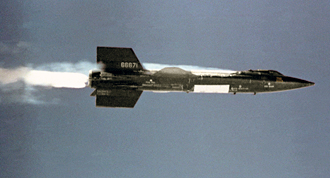
First flown in 1959, the three X-15 aircraft made a total of 199 flights. Flight maximums of 354,200 feet in altitude and a speed of 4,520 mph were obtained. The final flight occurred on Oct. 24, 1968. The X-15 was manufactured by North American Aviation (NAA).
It was a missile-shaped vehicle with an unusual wedge-shaped vertical tail, thin stubby wings, and unique side fairings that extended along the side of the fuselage. The X-15 weighed about 12,295 pounds empty and approximately 31,275 pounds at launch. The rocket engine, the XLR-99, was pilot-controlled and was capable of developing 57,000 pound of rated thrust. It was manufactured by the Reaction Motors Division of Thiokol Chemical Corp. Before that engine was installed, the aircraft was powered by two XLR-11 rocket engines.
The X-15 research aircraft was developed to provide in-flight information and data on aerodynamics, structures, flight controls, and the physiological aspects of high-speed, high-altitude flight. The aircraft was later used as a testbed to carry various scientific experiments beyond the Earth's atmosphere.
For flight in the dense air of the lower atmosphere, the X-15 used conventional aerodynamic controls such as vertical stabilizers to control yaw and horizontal stabilizers to control pitch when moving in synchronization, or roll when moved differentially.
For flight in the thin air outside of the appreciable Earth's atmosphere, the X-15 used a reaction control system. Eight hydrogen peroxide thrust rockets located on the nose of the aircraft provided pitch and yaw control. Four of them on the wings (two on each wing) furnished roll control.
Because the X-15 consumed a large amount of fuel, it was air launched from a B-52 aircraft at 45,000 feet and a speed of about 500 mph. Depending on the mission, the rocket engine provided thrust for the first 80 to 120 seconds of flight. The remainder of the normal 10- to 11-minute flight was without power and ended with a 200-mph glide landing.
Generally, one of two types of X-15 flight profiles was used--a high-altitude flight plan that called for the pilot to maintain a steep rate of climb, or a speed profile that called for the pilot to push over and maintain a level altitude.
X-15 Flight Summary
X-15 pilots in chronological order with total flights:
- A. Scott Crossfield, NAA, 14
- Joseph A. Walker, NASA, 25
- Robert M. White, USAF, 16
- Forrest S. Petersen, USN, 5
- John B. McKay, NASA, 29
- Robert A. Rushworth, USAF, 34
- Neil A. Armstrong, NASA, 7
- Joe H. Engle, USAF, 16
- Milton O. Thompson, NASA, 14
- William J. Knight, USAF, 16
- William H. Dana, NASA, 16
- Michael J. Adams, USAF, 7
The fastest speed (basic aircraft) was 4,104 mph on flight number 1-30-51 (taking place on June 27, 1962) with pilot Joe Walker.
The fastest speed with tanks was 4,520 mph (Mach 6.7) on flight 2-53-97 with pilot William Knight (taking place on Oct. 3, 1967).
The highest altitude was 354,200 feet (67 miles) on flight 3-22-36 (taking place on Aug. 22, 1963).
The total distance flown was 41,763.8 miles (statute).
The total flights of the X-15 was 199 between 1959 and 1968.
Hours above Mach (cumulative):
- Mach 1-18 hours, 16 minutes, and 28 seconds;
- Mach 2-12 hours, 10 minutes, and 44 seconds;
- Mach 3-8 hours, 51 minutes, and 33 seconds;
- Mach 4-5 hours, 58 minutes, and 52 seconds;
- Mach 5-1 hours, 25 minutes, and 33 seconds;
- Mach 6-1 minutes and 18 seconds.
Total: 30 hours, 14 minutes, 57.2 seconds
XB-70, 1966-1969
The XB-70 was the world's largest experimental aircraft. It was capable of flight at speeds of three times the speed of sound (roughly 2,000 mph) at altitudes of 70,000 feet. It was used to collect in-flight information for use in the design of future supersonic aircraft, military and civilian.

The major objectives of the XB-70 flight research program were to study the airplane's stability and handling characteristics, to evaluate its response to atmospheric turbulence, and to determine the aerodynamic and propulsion performance. In addition there were secondary objectives to measure the noise and friction associated with airflow over the airplane and to determine the levels and extent of the engine noise during takeoff, landing, and ground operations.
The XB-70 was about 186 feet long, 33 feet high, with a wingspan of 105 feet. Originally conceived as an advanced bomber for the U. S. Air Force, the XB-70 was limited to production of two aircraft when it was decided to limit the aircraft's mission to flight research. The first flight of the XB-70 was made on Sept. 21, 1964. The number two XB-70 was destroyed in a mid-air collision on June 8, 1966. Program management of the NASA-Air Force research effort was assigned to NASA in March 1967. The final flight was flown on Feb. 4, 1969.
Designed by Rockwell International, the XB-70 had a long fuselage with a canard or horizontal stabilizer mounted just behind the crew compartment. It had a sharply swept 65.6-percent delta wing. The outer portion of the wing could be folded down in flight to provide greater lateral-directional stability. The airplane had two windshields. A moveable outer windshield was raised for high-speed flight to reduce drag and lowered for greater visibility during takeoff and landing. The forward fuselage was constructed of riveted titanium frames and skin. The remainder of the airplane was constructed almost entirely of stainless steel. The skin was a brazed stainless-steel honeycomb material. Six General Electric YJ93-3 turbojet engines, each in the 30,000-pound-thrust class, powered the XB-70. Internal geometry of the inlets was controllable to maintain the most efficient airflow to the engines.
XB-70 Flight Summary
XB-70 pilots in chronological order and number of flights as pilot and co-pilot:
- Alvin White, NAA, 49 as pilot, 18 as co-pilot
- Joseph Cotton, USAF, 19 as pilot, 43 as co-pilot
- Van Shepard, NAA, 23 as pilot, 23 as co-pilot
- Fitzhugh Fulton, USAF and NASA, 31 as pilot, 32 as co-pilot
- Carl Cross, USAF, 1 as co-pilot
- Donald Mallick, NASA, 4 as pilot, 5 as co-pilot
- Emil Sturmthal, USAF, 3 as pilot, 7 as co-pilot
The first flight was on Sept. 21, 1964, with White and Cotton as crew.
The final flight was on Feb. 4, 1969, with Fulton and Sturmthal as crew.
The fastest flight in terms of miles per hour was on Jan. 12, 1966; the speed was 2,020 mph with White and Cotton as crew.
The fastest Mach flight was on April 12, 1966; it achieved Mach 3.08 with White and Cotton as crew.
The highest flight was on March 19, 1966; it attained 74,000 feet with White and Shepard as crew.
The total flight time was 252 hr and 38 min. The breakdown of flight time was:
- Subsonic, 145 hr and 28 min;
- Mach 1-2, 55 hr and 50 min;
- Mach 2-3, 49 hr and 32 min;
- Mach 3, 1 hr and 48 min.